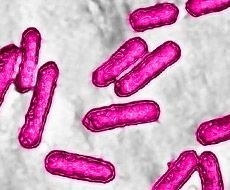Medical expert of the article
New publications
Listeriosis
Last reviewed: 05.07.2025

All iLive content is medically reviewed or fact checked to ensure as much factual accuracy as possible.
We have strict sourcing guidelines and only link to reputable media sites, academic research institutions and, whenever possible, medically peer reviewed studies. Note that the numbers in parentheses ([1], [2], etc.) are clickable links to these studies.
If you feel that any of our content is inaccurate, out-of-date, or otherwise questionable, please select it and press Ctrl + Enter.

Listeriosis (listerellosis, Tigris River disease, neurellosis, neonatal granulomatosis) is an infectious disease of humans and animals caused by listeria, characterized by multiple sources of the infectious agent, a variety of routes and factors of its transmission, polymorphism of clinical manifestations and high mortality.
Listeriosis is a bacteremia, meningitis, cerebritis, dermatitis, oculoglandular syndrome, intrauterine and neonatal infections, or, rarely, endocarditis caused by Listeria species. Symptoms of listeriosis vary depending on the organ system affected and include intrauterine death or perinatal infection. Treatment of listeriosis includes penicillin, ampicillin (often in combination with aminoglycosides), and trimethoprim-sulfamethoxazole.
What causes listeriosis?
Listeriosis is caused by Listeria monocytogenes, which are small, acid-resistant, nonspore-forming, nonencapsulated, non-stable, facultative anaerobes. They are found worldwide in the environment and intestines of mammals, birds, arachnids, and crustaceans. There are several species of Listeria monocytogenes, but L monocytogenes is the dominant pathogen in humans. The incidence in the United States is 7 or more cases per 100,000 per year. There is a seasonal increase in incidence in the summer. Attacks are most common in neonates and adults aged 60 years or older. Immunocompromised patients are at high risk.
Infection usually occurs through consumption of contaminated dairy products, raw vegetables, or meat. Infection is facilitated by the fact that L. monocytogenes can survive and multiply in refrigerated conditions. Infection can also occur through direct contact and during butchering of infected animals. Infection can be transmitted from mother to child during pregnancy and childbirth, and can cause miscarriage.
What are the symptoms of listeriosis?
Primary listeremia is rare and presents with high fever without local symptoms or signs. Endocarditis, peritonitis, osteomyelitis, cholecystitis, and pleuropneumonia may occur. Listeremia may lead to intrauterine infection, chorioamnionitis, premature birth, fetal death, and neonatal infection.
Meningitis due to Listeria occurs in approximately 20% of cases in neonates and individuals over 60 years of age. In 20% of cases, meningitis progresses to cerebritis or diffuse encephalitis, and, rarely, to rhombencephalitis and abscesses. Rhombencephalitis manifests itself as impaired consciousness, cranial nerve paresis, cerebral signs, motor and sensory impairment.
Oculoglandular listeriosis may cause ophthalmitis and regional lymph node enlargement. The disease may follow conjunctival infection and, if untreated, may progress to bacteremia and meningitis.
How is listeriosis diagnosed?
Listeriosis is diagnosed by culturing blood or cerebrospinal fluid samples. The laboratory should be alerted to the suspicion of L monocytogenes because this organism is easily confused with diphtheroids. In all Listeria infections, IgG agglutinin titers peak 2–4 weeks after onset of illness.
What tests are needed?
Who to contact?
How is listeriosis treated?
Meningitis caused by Listeria is best treated with ampicillin 2 g intravenously every 4 hours. Most authors recommend the addition of an aminoglycoside to ampicillin, as these drugs act synergistically in vitro. Children are given ampicillin 50-100 mg/kg intravenously every 6 hours. Cephalosporins are ineffective in treating Listeria infections.
In endocarditis and primary listeremia, listeriosis is treated with ampicillin 2 g IV every 4 hours in combination with gentamicin (for a synergistic effect) for 6 weeks (for endocarditis) and for 2 weeks after temperature normalization (for listeremia). Oculoglandular listeriosis and listeria dermatitis should respond well to treatment with erythromycin 10 mg/kg orally every 6 hours for up to 1 week after temperature normalization. Trimethoprim-sulfamethoxazole 5/25 mg/kg IV every 8 hours may be used as an alternative.
What is the prognosis for listeriosis?
Listeriosis has a favorable prognosis in the glandular form and a serious one in other forms.

